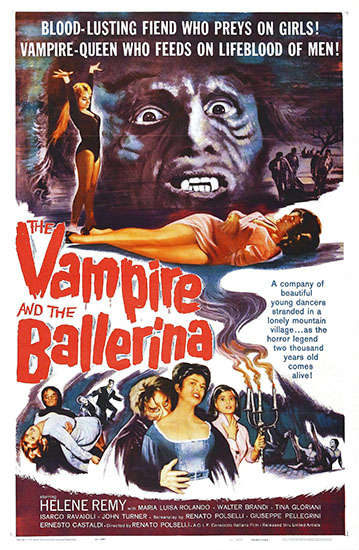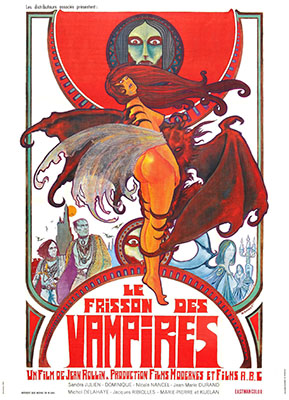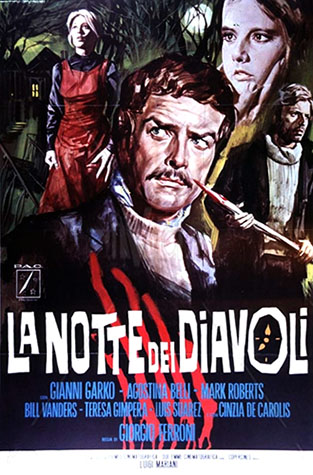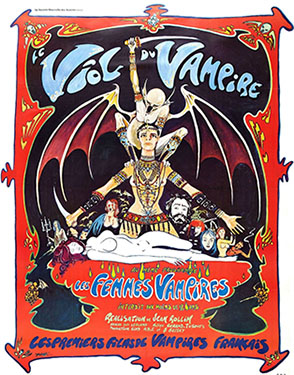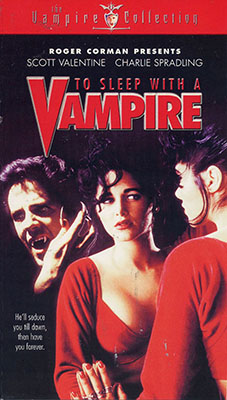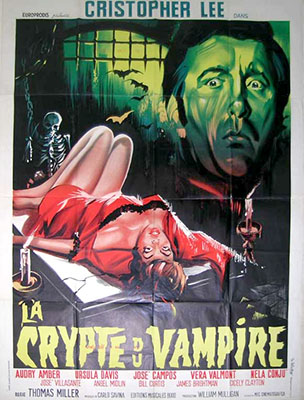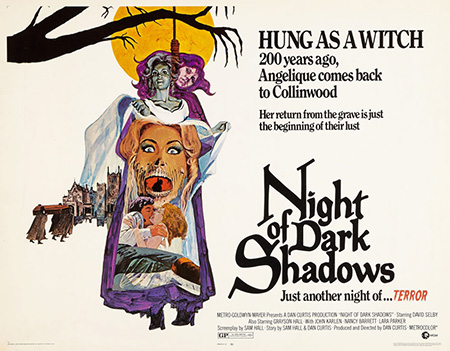
Night Of Dark Shadows (1971)
Quentin Collins (David Selby of “Dark Shadows”) inherits the estate of Collinwood and moves in with his wife Tracy (Kate Jackson of “Scarecrow and Mrs. King”, “Dark Shadows”). Not long after arriving Quentin begins to have visions of a long dead witch named Angelique (Lara Parker of “Dark Shadows”) along with his ancestor Charles Collins (also Selby). With the help of the sinister housekeeper Carlotta (Grayson Hall: The Night of the Iguana, “Dark Shadows”) the spirit of Angelique slowly starts manipulating Quentin. Will Tracy with the help of husband and wife novelist team Alex (John Karlen: “Murder She Wrote”, “Dark Shadows”) and Claire (Nancy Barrett of, you guessed it, “Dark Shadows”) be able to free Quentin from Angelique’s clutches before it is too late?
In 1970 “Dark Shadows” creator/producer Dan Curtis (Burnt Offerings, The Night Stalker) decided the time was right to a make a feature length “Dark Shadows” film. The resulting effort was the excellent House Of Dark Shadows, a film that took the high points of the first major storyline of vampire Barnabas Collins and boiled it down into 97 minutes. It was a box office success and plans for a sequel were soon launched but by then the show had gone off the air and Jonathan Frid (Barnabas) would not make the film due to fear of typecasting. (Too late really. He should have done it because he was already typecast.) Dan and screenwriter Sam Hall quickly came up with an idea that loosely corresponded with the television show’s ‘parallel time’ episodes. And I’ll say this now, you do not have to be familiar with the show to watch this film.
Most of the folks in the film were in “Dark Shadows” the television show. Whereas Grayson Hall played (mainly) Dr. Julia Hoffman on the show, here she plays Carlotta the housekeeper, a character that never appeared on the show. Conversely David Selby did play Quentin Collins on the show but apparently not the same Quentin Collins that we see in the film. In fact Selby played two different Quentin Collinses on the show. So it can get a bit confusing. It’s made mention in the film that Collinwood was left to Quentin by his aunt Elizabeth (played on the show by Joan Bennett (Suspiria) in her only television role) and although we never see her it seems to be an attempt to tie the film to the series. In fact the witch Angelique is played by the same actress that played Angelique in the television show. But in the film it seems unlikely that this is the same Angelique that cursed Barnabas to be a vampire, one reason being that the television Angelique’s last name is Bouchard while the film’s Angelique has the surname of Collins. I say all this not to pick on the film, as I am a huge “Dark Shadows” fan, but to bring up my next point:
MGM forced Dan Curtis to cut 34 minutes from the film bringing it down from a run time of 129 minutes to 94. And they only gave him 24 hours to do it. Actually he originally cut it down to 97 minutes and the remainder was cut in order to achieve a GP rating. There is one particularly bloody scene in the film and one wonders how many more graphic scenes were cut. The film was successful but not as much as its predecessor and fans have always pointed to the editing as the main reason why. Watching the film it is obvious it was hacked up (I hesitate to use the word hacked because I do not believe that that was Curtis’ mindset while he was trimming) but not in an overly confusing way. People you’ve never seen before don’t pop up suddenly and the film doesn’t make any wild jumps in logic. It just feels like there are some things missing. According to Wikipedia those things are: another flashback to Angelique and Charles Collins, two more scenes of Gerard the handyman/caretaker, romantic scenes of Quentin and Tracy, more hanging scenes, and a candlelit exorcism scene that was to be the climax. Reportedly in 1999 the footage was discovered sans audio, 16 new scenes total and bits that extended scenes, injecting a darker tone. Hopes were high when the current DVD and blu-ray releases were announced that Warner Home Video would be reinstating the scenes but it didn’t happen. All we got for extras was a trailer.
As far as the editing that I did notice, two things in particular jump to mind. While reading Wikipedia it mentions that Alex and Claire Jenkins move into the cottage along with Quentin and Tracy moving into the mansion. Watching the film it seems to me that Alex and Claire had already been living there for a while as it is mentioned that Alex had met Carlotta the housekeeper a while before when they first moved in, while we see Quentin and Tracy meet Carlotta for the first time at the beginning of the film. (And while I am at it, Quentin says he has never been to Collinwood before which makes him being the television Quentin (either of them) even more unlikely.) The other is Wikipedia’s mention of Charles’ fate in the past. Without spoiling it I will say that unless I missed it, there is a discrepancy there as well. It is impossible for me to say if this is a case of me missing something, those particular parts being edited out, Wikipedia going off a slightly longer script/source, or Wikipedia simply being incorrect.
But what about the film itself? I enjoy it quite a bit while lamenting what is lost. Atmospheric cinematography from Richard Shore compliments Curtis’ surefooted direction. Flashbacks have the woozy blurring of the sides of the frame. The hanging scene is shot from some interesting angles. The film was shot on the grounds of Lyndhurst estate, a huge gothic manor, which is a huge asset to the film’s production value. Robert Cobert’s score ranges from ominous piano to harmonica (not as bad as it sounds) to creepy music lifted straight from the show. Selby does a great job as the haunted Quentin, a pre- Charlie’s Angels Kate Jackson is impossibly cute and perky and Lara Parker’s Angelique is threateningly evil in flashback while being very convincing as the ghostly apparition in the present. There’s one effect that is a bit cheesy but nothing out of line with films from this period. Unlike House Of Dark Shadows this was made without the burden of having to make the show at the same time and it shows (not that House feels particularly rushed.) That fact makes it even harder to accept that the studio demanded cuts. This could be a minor classic 70’s horror film (and I personally think it is anyway) in more people’s minds if there were a longer, slightly more realized cut out there somewhere. And speaking of the two films I’ve always thought that they should have swapped titles. This film seems a better fit with the title House Of Dark Shadows since it is Quentin’s arrival at the house which sets the film’s events into motion.
An interesting bit of trivia is the production’s hiring of famed paranormal researcher Hans Holzer (several books and an Amityville investigation) to give some authenticity to the film but sadly a lot of that seems to have hit the cutting room floor in the form of the exorcism. A prologue was written with a hippie sneaking into the house and being killed by Angelique and Gerard but it was never filmed which is interesting because the film does open a bit abruptly.
I recommend Night of Dark Shadowns to the 70’s horror film fan with the caveat that you are not (and probably won’t ever be) seeing what Dan Curtis intended for you to. He took the risky step of making a “Dark Shadows” film without the character of Barnabas and despite the cuts came out with a visually pleasing gothic chiller. But oh what might have been.
-Brad Hogue
